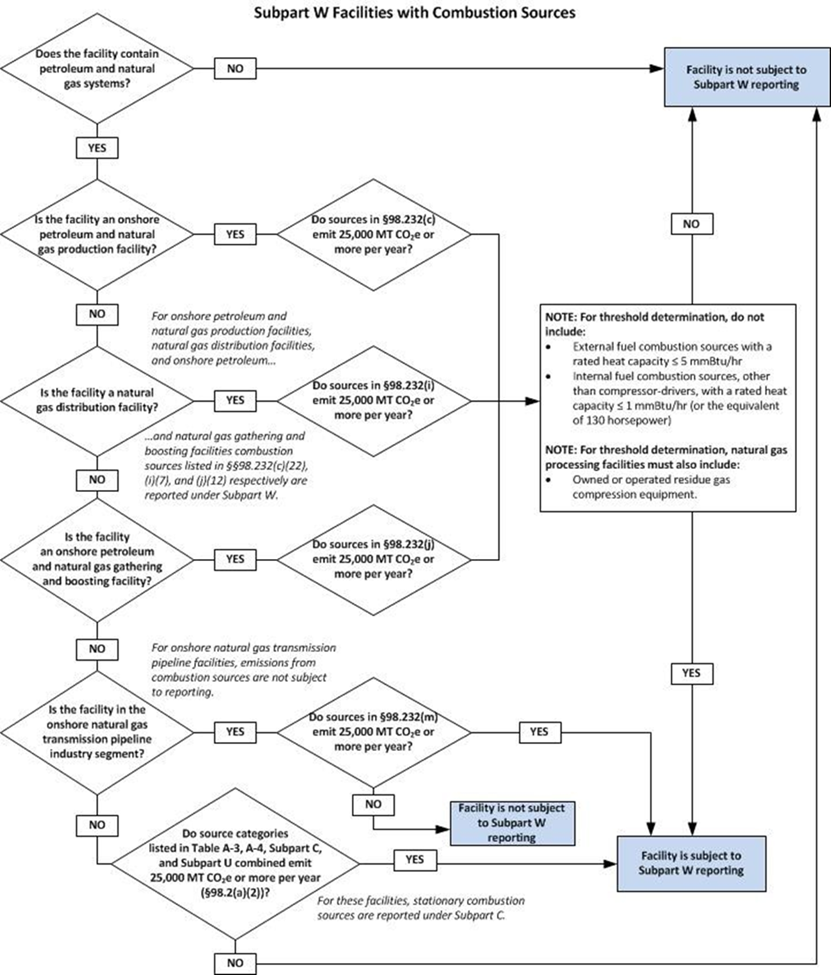Q667. How do I determine applicability for Subpart W facilities with stationary combustion sources?
Changed
A667. Subpart W facilities with stationary combustion sources are subject to reporting if they meet the requirements of either 40 CFR 98.2(a)(2), as referenced by 98.231(a), or 98.231(a)(1)-(4).
The emissions threshold in 40 CFR 98.2(a)(2) is 25,000 metric tons of CO2e per year emitted from sources in subpart W, all source categories contained in Table A-3 and Table A-4, stationary combustion sources (subpart C), and miscellaneous uses of carbonates (subpart U). However, this threshold is modified by the provisions of 40 CFR 98.231(a)(1)-(3) and 40 CFR 98.231(b) as discussed below. (This threshold is also modified by the provisions of 40 CFR 98.231(a)(4) but that modification is not discussed further in this response because facilities in the onshore natural gas transmission pipeline industry segment are not required to include combustion emissions.)
In the situation where the facility is an onshore petroleum and natural gas production facility, as defined in 40 CFR 98.238, 40 CFR 98.231(a)(1) directs the reporter to calculate emissions in accordance with 40 CFR 98.232(c) and compare those emissions to a 25,000 metric tons of CO2e per year threshold. Therefore, combustion emissions would be calculated per 40 CFR 98.232(c)(22), which states:
You must use the methods in §98.233(z) and report under this subpart the emissions of CO2, CH4, and N2O from stationary or portable fuel combustion equipment that cannot move on roadways under its own power and drive train, and that is located at an onshore petroleum and natural gas production facility as defined in §98.238. Stationary or portable equipment are the following equipment, which are integral to the extraction, processing, or movement of oil or natural gas: well drilling and completion equipment, workover equipment, natural gas dehydrators, natural gas compressors, electrical generators, steam boilers, and process heaters.
In the situation where the facility is a natural gas distribution facility, 40 CFR 98.231(a)(2) directs the reporter to calculate emissions in accordance with 40 CFR 98.232(i) and compare those emissions to a 25,000 metric tons of CO2e per year threshold. Therefore, combustion emissions would be calculated per 40 CFR 98.232(i)(7), which states:
Report under subpart W of this part the emissions of CO2, CH4, and N2O emissions from stationary fuel combustion sources following the methods in §98.233(z)
In the situation where the facility is an onshore petroleum and natural gas gathering and boosting facility, as defined in 40 CFR 98.238, 40 CFR 98.231(a)(3) directs the reporter to calculate emissions in accordance with 40 CFR 98.232(j) and compare those emissions to a 25,000 metric tons of CO2e per year threshold. Therefore, combustion emissions would be calculated per 40 CFR 98.232(j)(12), which states:
You must use the methods in § 98.233(z) and report under this subpart the emissions of CO2, CH4, and N2O from stationary or portable fuel combustion equipment that cannot move on roadways under its own power and drive train, and that is located at an onshore petroleum and natural gas gathering and boosting facility as defined in § 98.238. Stationary or portable equipment includes the following equipment, which are integral to the movement of natural gas: Natural gas dehydrators, natural gas compressors, electrical generators, steam boilers, and process heaters.
40 CFR 98.233(z) allows onshore petroleum and natural gas production, onshore petroleum and natural gas gathering and boosting, and natural gas distribution facilities to exclude external fuel combustion sources with a rated heat capacity less than or equal to 5 mmBtu/hr or internal fuel combustion sources, other than compressor drivers, with a rated heat capacity less than or equal to 1 mmBtu/hr (or the equivalent of 130 horsepower) from the threshold determinations and reporting.
Finally, 40 CFR 98.231(b) modifies 40 CFR 98.2(a)(2) for natural gas processing facilities by requiring the inclusion of owned or operated residue gas compression equipment.

